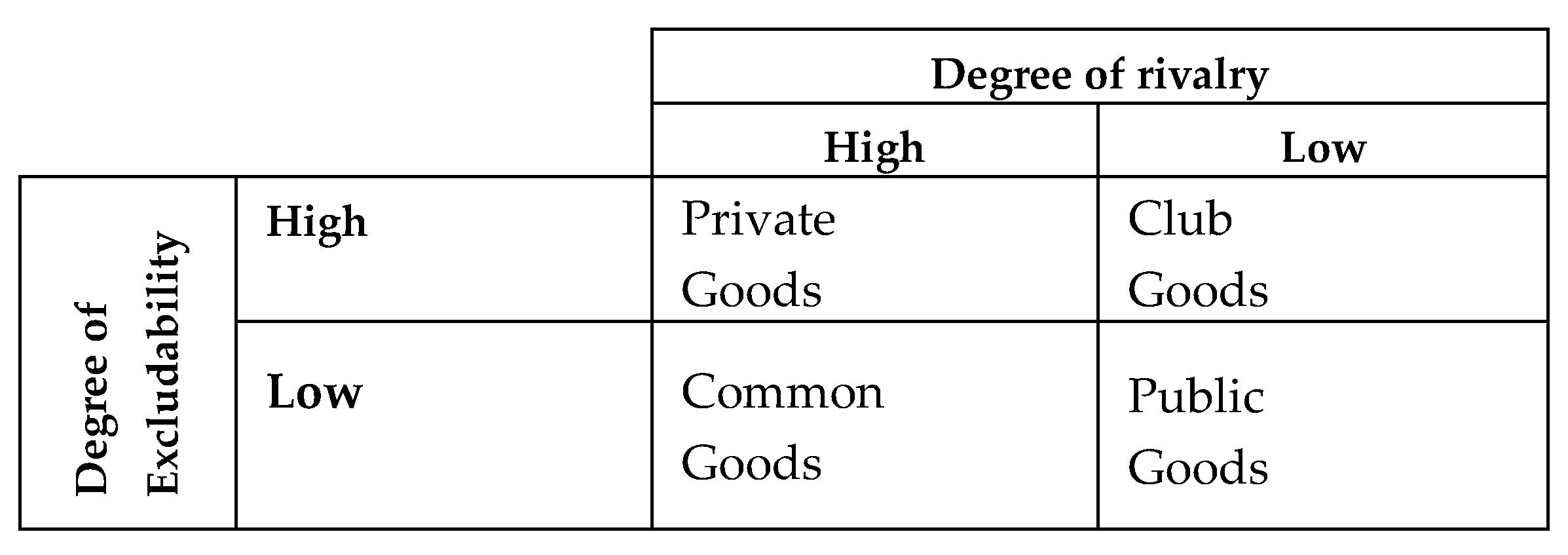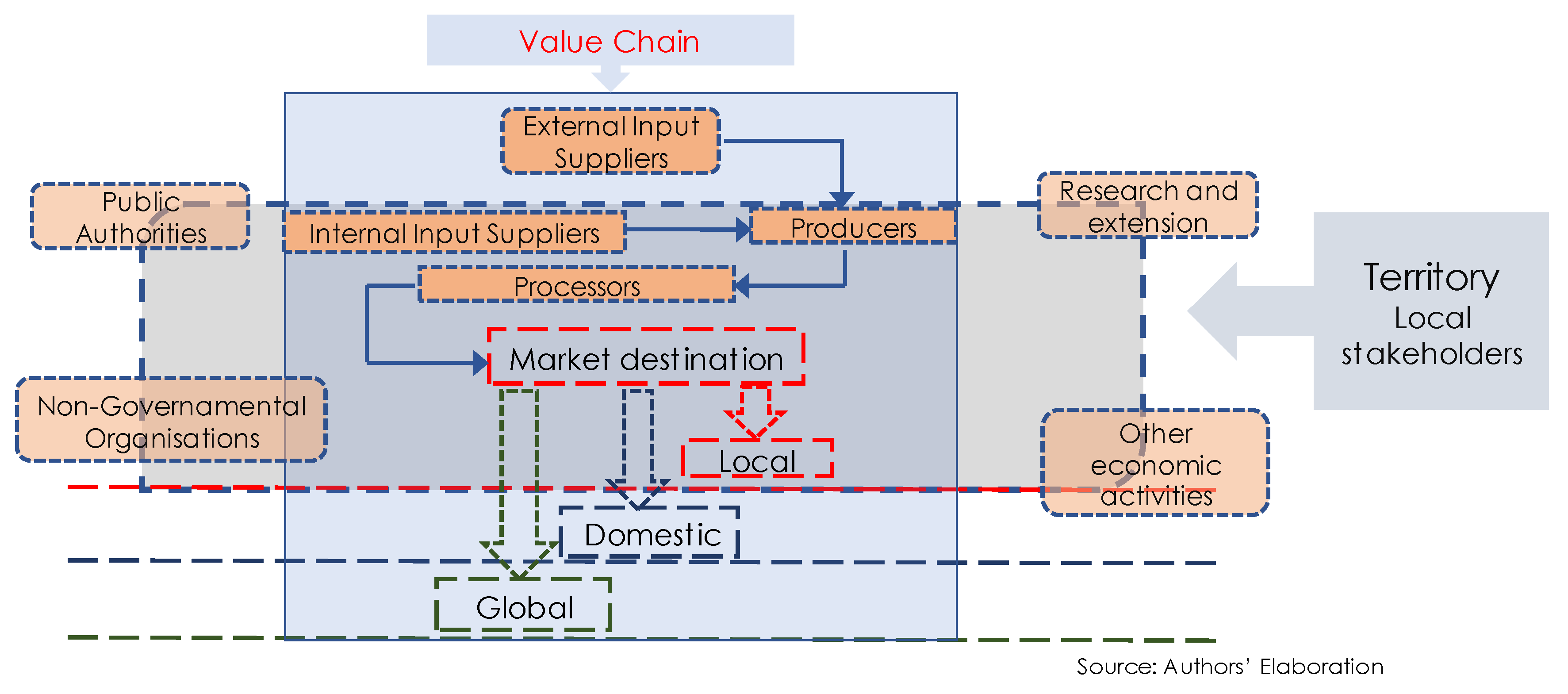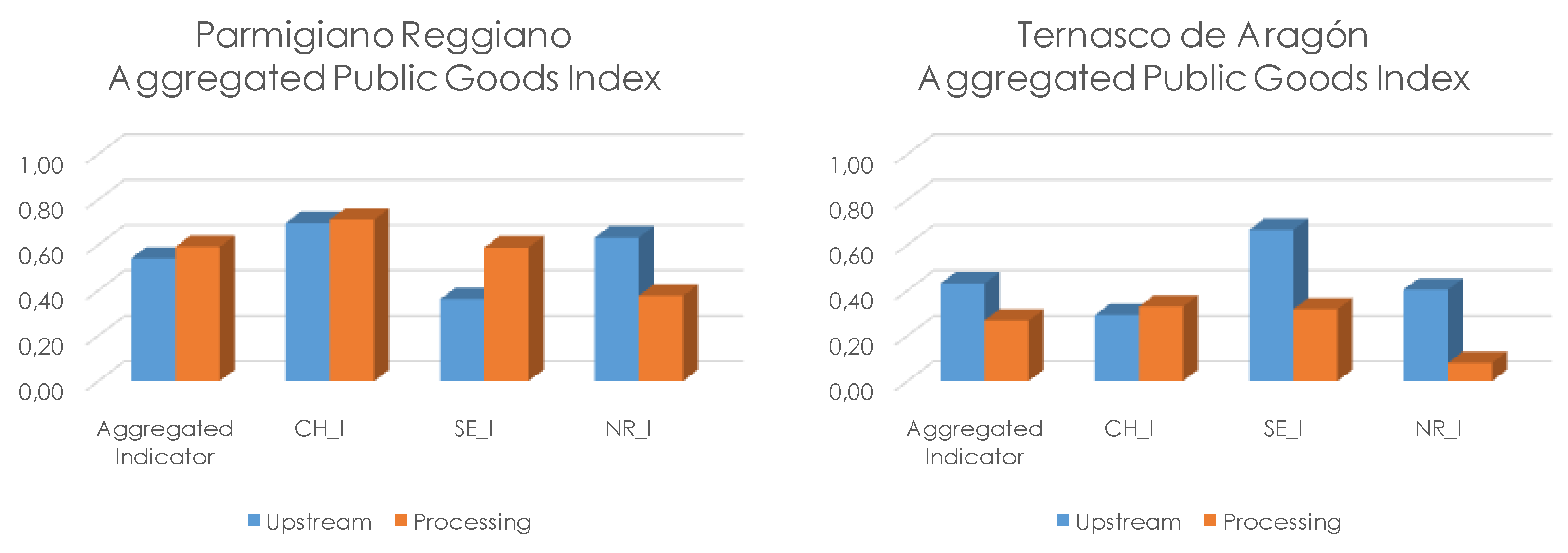Are Geographical Indication Products Fostering Public Goods? Some Evidence from Europe
Abstract
1. Introduction
2. Materials and Methods
A Theoretical Framework for the Assessment of Public Goods in Food Quality Schemes
- 1.
- The carbon footprint/product (En1_a) and the carbon footprint/area (En1_b);
- 2.
- The water footprint (respectively, green water: En3_a, grey water: En3_b, and blue water: En3_c)
- 3.
- The labour-to-production ratio (So1_a) and the profit-to-labour ratio (So1_b);
- 4.
- Educational attainment (So3_a);
- 5.
- Bargain power distribution (So2);
- 6.
- The local multiplier (Ec2) for spillover socio-economic effects.
- (i)
- The contribution of FQSs to the non-farm rural economy in terms of auxiliary services. They are conceived as a wide range of activities covering services directly related to the production system, such as collateral consulting services (e.g., chemical labs for milk analysis, extension services, or administrative offices for farmers) or manufacturing activities (e.g., packaging and marketing services), as well as collateral activities (e.g., in the tourism or artisan sectors). In this way it is possible to assess whether the FQS product is considered a fly-wheel for the local area where its production is based;
- (ii)
- The contribution of different governance models to ensure the valorisation of producers’ know-how and local resources. Governance is a complex feature with several implications which are not easy to assess [25]. In this case, governance is considered the ability of the system to manage quality and network relationships with the aim of improving market efficiency and social cohesion;
- (iii)
- Social cohesion as a way to booster social capital and social networks. The presence of producer or inter-professional Organisations could in fact influence not only economic performance but particularly global sustainability at a local level, thanks to the representativeness of the interests of all the actors involved.
3. Results
3.1. Parmigiano Reggiano Local Agri-Food System
3.2. Ternasco de Aragón Local Agri-Food System
4. Discussion
5. Conclusions
Author Contributions
Funding
Conflicts of Interest
Abbreviations
| CoP | Code of practice |
| FAO | Food and Agriculture Organization of the United Nations |
| FQS | Food Quality Scheme |
| GI | Geographical indication |
| LAFS | Local agri-food system |
| OECD | Organisation for Economic Co-operation and Development |
| PDO | Protected designation of origin |
| PG | Public good |
| PGI | Protected geographical indication |
| SAFA | Sustainability assessment of food and agriculture systems indicators |
| TRIPS | Trade related aspects of intellectual property rights |
| WTP | Willingness to pay |
References
- Vandecandelaere, E.; Arfini, F.; Belletti, G.; Marescotti, A. Linking People, Places and Products: A Guide for Promoting Quality Linked to Geographical Origin and Sustainable Geographical Indications; FAO: Rome, Italy, 2009; ISBN 978-92-5-106656-0. [Google Scholar]
- Belletti, G. Costi e benefici delle denominazioni geografiche per le imprese e per i sistemi territoriali. In Prodotti tipici e denominazioni geografiche: Strumenti di tutela e valorizzazione; Arfini, F., Belletti, G., Marescotti, A., Eds.; Tellus: Rome, Italy, 2010; pp. 147–176. ISBN 9788889110157. [Google Scholar]
- Samuelson, P.A. The Pure Theory of Public Expenditure. Rev. Econ. Stat. 1954, 36, 387–389. [Google Scholar] [CrossRef]
- Belletti, G.; Marescotti, A.; Touzard, J.-M. Geographical Indications, Public Goods, and Sustainable Development: The Roles of Actors’ Strategies and Public Policies. World Dev. 2017, 98, 45–57. [Google Scholar] [CrossRef]
- OECD. Multifunctionality. Towards an Analytical Framework; OECD: Paris, France, 2001; ISBN 1280081708. [Google Scholar]
- Van Huylenbroeck, G.; Durand, G. (Eds.) Multifunctional Agriculture: A New Paradigm for European Agriculture and Rural Development; Ashgate Publishing: Aldershot, UK, 2003; ISBN 0-7546-3576-7. [Google Scholar]
- Velazquez, B.E. Multifunzionalità: Definizione, aspetti tecnico-economici e strumenti. In Verso il riconoscimento di una agricoltura multifunzionale: Teorie, politiche, strumenti; Henke, R., Ed.; Edizioni scientifiche italiane: Neaples, Italy, 2004; pp. 21–47. ISBN 8849508360. [Google Scholar]
- Török, Á.; Moir, H.V.J. Understanding the real-world impact of GIs: A critical review of the empirical economic literature. In Proceedings of the Policy Forum, Australian National University, Canberra, Australia, 21 June 2018. [Google Scholar]
- Arfini, F.; Mancini, M.C.; Donati, M. (Eds.) Local Agri-Food Systems in a Global World. Market, Social and Environmental Challenges; Cambridge Scholars Publishing: Newcastle upon Tyne, UK, 2012; ISBN 9781443836647. [Google Scholar]
- Raimondi, V.; Curzi, D.; Arfini, F.; Olper, A.; Aghabeygi, M. Evaluating Socio-Economic Impacts of PDO on Rural Areas. In Proceedings of the 7th AIEAA Conference, Conegliano, Italy, 14–15 June 2018. [Google Scholar]
- Barjolle, D.; Reviron, S.; Sylvander, B. Création et distribution de valeur économique dans les filières de fromages AOP. In Economie et Sociétés Série: “Systèmes agroalimentaires”; Presses de l’ISMEA: Paris, France, 2007; Volume 41, pp. 1507–1524. [Google Scholar]
- Mérel, P. Measuring market power in the French Comté cheese market. Eur. Rev. Agric. Econ. 2009, 36, 31–51. [Google Scholar] [CrossRef]
- Verbeke, W.; Pieniak, Z.; Guerrero, L.; Hersleth, M. Consumers’ Awareness and Attitudinal Determinants of European Union Quality Label Use on Traditional Foods. Bio-Based Appl. Econ. 2012, 2, 213–229. [Google Scholar] [CrossRef]
- Barjolle, D.; Sylvander, B. Some Factors of Success for Origin Labelled Products in Agri-Food Supply Chains in Europe: Market, Internal Resources and Institutions. In Proceedings of the 67th EAAE Seminar, Le Mans, France, 28–30 October 2002; ISBN 9782738009500. [Google Scholar]
- Paus, M.; Reviron, S. Evaluation of geographical indications: Literature review. In The Effects of Protecting Geographical Indications. Ways and Means of Their Evaluation; Belletti, G., Marescotti, A., Paus, M., Reviron, S., Deppeler, A., Stamm, H., Thévenod-Mottet, E., Eds.; Swiss Federal Institute of Intellectual Property: Bern, Switzerland, 2011; pp. 11–30. [Google Scholar] [CrossRef]
- Arfini, F.; Mancini, M.C.; Veneziani, M.; Donati, M. (Eds.) Intellectual Property Rights for Geographical Indications: What Is at Stake in the TTIP? Cambridge Scholars Publishing: Newcastle upon Tyne, UK, 2016; ISBN 9781443894814. [Google Scholar]
- Grunert, K.G. Food Quality and Safety: Consumer Perception and Demand. Eur. Rev. Agric. Econ. 2005, 32, 369–391. [Google Scholar] [CrossRef]
- Arfini, F. The Value of Typical Products: The Case of Prosciutto di Parma and Parmigiano Reggiano Cheese. In Proceedings of the 67th EAAE Seminar, Le Mans, France, 28–30 October 2002; ISBN 9782738009500. [Google Scholar]
- Anania, G.; Nistico, R. Public Regulation as a Substitute for Trust in Quality Food Markets: What if the Trust Substitute cannot be Fully Trusted? J. Inst. Theor. Econ. 2004, 160, 681–701. [Google Scholar] [CrossRef]
- Arfini, F.; Antonioli, F.; Bellassen, V.; Brennan, M.; Fumel, M.; Gorton, M.; Hartmann, M.; Hawes, D.R.; Mancini, M.C.; Roos, G.; et al. Conceptual Framework and Literature Review for Understanding the Social, Environmental and Economic Impacts of FQS, SFSC and Varying PSFP Policies on Agri-Food Chain Participants and Rural Territories. 2016. Available online: https://www.strength2food.eu/wp-content/uploads/2018/04/D3_1.Conceptual-Framework.pdf (accessed on 7 January 2019).
- Belletti, G. Il ruolo del nome (geografico) e l’importanza della regolazione e del suo uso. In Prodotti tipici e denominazioni geografiche: Strumenti di tutela e valorizzazione; Arfini, F., Belletti, G., Marescotti, A., Eds.; Tellus: Rome, Italy, 2010; pp. 23–31. ISBN 9788889110157. [Google Scholar]
- CIRAD-SAR. Dossier Systèmes agroalimentaires localisés: Organisations, innovations et développement local, orientations et perspectives issues de la consultation du CIRAD. Stratégies de recherché dans le domaine de la socio-économie de l’alimentation et des industries agroalimentaires. 1996. Available online: http://agritrop.cirad.fr/575624/1/dk575624.pdf (accessed on 7 January 2019).
- FAO. SAFA Sustainability Assessment of Food and Agriculture Systems Indicators; FAO: Rome, Italy, 2013; ISBN 978-92-5-108486-1. [Google Scholar]
- Bellassen, V.; Giraud, G.; Hilal, M.; Arfini, F.; Barczak, A.; Bodini, A.; Brennan, M.; Drut, M.; Duboys de Labarre, M.; Gorton, M.; et al. Methods and Indicators for Measuring the Social, Environmental and Economic Impacts of Food Quality Schemes. 2016. Available online: https://www.strength2food.eu/wp-content/uploads/2018/04/D3_2_Methodological-Handbook.pdf (accessed on 7 January 2019).
- Gereffi, G.; Humphrey, J.; Sturgeon, T. The Governance of Global Value Chains. Rev. Int. Political Econ. 2005, 12, 78–104. [Google Scholar] [CrossRef]
- Gan, X.; Fernandez, I.C.; Guo, J.; Wilson, M.; Zhao, Y.; Zhou, B.; Wu, J. When to use what: Methods for weighting and aggregating sustainability indicators. Ecol. Indic. 2017, 81, 491–502. [Google Scholar] [CrossRef]
- Stiglitz, J.E.; Sen, A.K.; Fitoussi, J.-P. Report by the Commission on the Measurement of Economic Performance and Social Progress; Commission on the Measurement of Economic Performance and Social Progress: Paris, France, 2009. [Google Scholar]
- Arfini, F.; Mancini, M.C. Synergies between localized agri-food systems and short supply chains for geographical indications in Italy. In Localizing Global Food; Kalfagianni, A., Skordili, S., Eds.; Routledge: London, UK, 2019; pp. 104–120. [Google Scholar]
- Consejo Regulador de la IGP Ternasco de Aragón. Pliego de condiciones de la Indicación Geográfica Protegida “Ternasco de Aragón”, Orden de modificación. 2016. Available online: http://www.aragon.es/estaticos/GobiernoAragon/Departamentos/AgriculturaGanaderiaMedioAmbiente/TEMAS_AGRICULTURA_GANADERIA/Areas/CALIDAD_AGROALIMENTARIA/PLIEGOS/TERNASCO_PLIEGO_R2017_2323_COM.pdf (accessed on 7 January 2019).





| Class of Public Goods | Indicator | Code | Typology |
|---|---|---|---|
| Indicators concerning Cultural Heritage Preservation | Communication activities | CH_1 | Qualitative |
| Value chain foreigner workers attraction | CH_2 | Qualitative | |
| Educational attainment | CH_3 | Quantitative (So3_a) | |
| Support touristic events | CH_4 | Qualitative | |
| Generational Change | CH_5 | Quantitative (So5_a) | |
| Labour-to-production ratio | CH_6 | Quantitative (So1_a) | |
| Educational Farm Activities | CH_7 | Qualitative | |
| Professional training on the FQS | CH_8 | Qualitative | |
| Profit-to-labour ratio | CH_9 | Quantitative (So1_b) | |
| PGs definition into CoP | CH_10 | Qualitative | |
| Indicators concerning Socio-Economic spillover effects | Participation to farmer unions | SE_1 | Qualitative |
| Participation to board association | SE_2 | Qualitative | |
| Participation to technical association | SE_3 | Qualitative | |
| Intensity of network relationship | SE_4 | Qualitative | |
| Relevance of cooperation system | SE_5 | Qualitative | |
| Bargain power distribution | SE_6 | Quantitative (So2) | |
| Governance actions | SE_7 | Qualitative | |
| Economic spillover effect | SE_8 | Quantitative (Ec2) | |
| PGs definition into CoP | SE_9 | Qualitative | |
| Indicators concerning use of Natural Resources | Animal welfare definition into CoP | NR_1 | Qualitative |
| Blue water | NR_2 | Quantitative (En3_c) | |
| Carbon footprint per Ha | NR_3 | Quantitative (En1_b) | |
| Carbon footprint per unit of product | NR_4 | Quantitative (En1_a) | |
| Green water | NR_5 | Quantitative (En3_a) | |
| Grey water | NR_6 | Quantitative (En3_b) | |
| PGs definition into CoP | NR_7 | Qualitative |
© 2019 by the authors. Licensee MDPI, Basel, Switzerland. This article is an open access article distributed under the terms and conditions of the Creative Commons Attribution (CC BY) license (http://creativecommons.org/licenses/by/4.0/).
Share and Cite
Arfini, F.; Cozzi, E.; Mancini, M.C.; Ferrer-Perez, H.; Gil, J.M. Are Geographical Indication Products Fostering Public Goods? Some Evidence from Europe. Sustainability 2019, 11, 272. https://doi.org/10.3390/su11010272
Arfini F, Cozzi E, Mancini MC, Ferrer-Perez H, Gil JM. Are Geographical Indication Products Fostering Public Goods? Some Evidence from Europe. Sustainability. 2019; 11(1):272. https://doi.org/10.3390/su11010272
Chicago/Turabian StyleArfini, Filippo, Elena Cozzi, Maria Cecilia Mancini, Hugo Ferrer-Perez, and José María Gil. 2019. "Are Geographical Indication Products Fostering Public Goods? Some Evidence from Europe" Sustainability 11, no. 1: 272. https://doi.org/10.3390/su11010272
APA StyleArfini, F., Cozzi, E., Mancini, M. C., Ferrer-Perez, H., & Gil, J. M. (2019). Are Geographical Indication Products Fostering Public Goods? Some Evidence from Europe. Sustainability, 11(1), 272. https://doi.org/10.3390/su11010272





